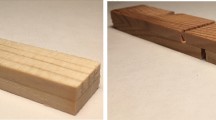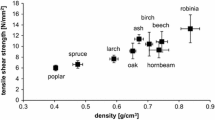Abstract
As wood construction increasingly uses engineered wood products worldwide, concerns arise about the integrity of the wood and adhesives used. Bondline strength is a crucial issue for engineered wood applications, especially in cold climates. In this study, Norway spruce (Picea abies) joints (150 mm × 20 mm × 10 mm) were bonded with seven commercially available adhesives: polyurethane (PUR), polyvinyl acetate (PVAc), emulsion-polymer-isocyanate (EPI), melamine-formaldehyde (MF), phenol-resorcinol-formaldehyde (PRF), melamine-urea-formaldehyde1 (MUF1), and melamine-urea-formaldehyde2 (MUF2). Each adhesive was tested at six temperatures: 20, −20, −30, −40, −50 and −60 °C. Generally, within the temperature test range, temperature changes significantly affected the shear strength of solid wood and wood joints. As the temperature decreased, the shear strength decreased. PUR adhesive in most cases resulted in the strongest shear strength and MUF adhesive resulted in the weakest. MF and PRF adhesives responded to temperature changes in a similar manner to that of the PUR adhesive. The shear strengths of wood joints with PVAc and EPI adhesives were more sensitive to temperature change. At low temperatures, the variability of shear strengths increased with all adhesives. Percent wood failures of joints bonded with different adhesives in most cases were not sensitive to temperature changes.




Similar content being viewed by others
References
Clauss S, Joscak M, Niemz P (2011) Thermal stability of glued wood joints measured by shear tests. Eur J Wood Prod 69(1):101–111
EN 15425 (2008) Adhesives, one component polyurethane for load bearing timber structures—Classification and performance requirements. European committee for standardization. Brussels, Belgium
EN 301 (2006) Adhesives, phenolic and aminoplastic, for load bearing timer structures—Classification and performance requirements. European committee for standardization. Brussels, Belgium
EN 302-1 (2004) Adhesives for load-bearing timber structures—Test methods—Part 1: Determination of bond strength in longitudinal tensile shear strength. European committee for standardization. Brussels, Belgium
Falkner H, Teutsch M (2006) Load-carrying capacity of glued laminated wood girders under temperature influence. Bautechnik 83(6):391–393
Frangi A, Fontana A, Mischler A (2004) Shear behavior of bond lines in glued laminated timber beams at high temperatures. Wood Sci Technol 38(2):119–126
Geissen A (1976) Über den Einfluss von Temperatur und Holzfeuchtigkeit auf die Elastizitäts- und Festigkeitseigenschaften des Holzes im Gefrierbereich (“Influence of temperature and wood moisture on the elastic and strength properties of timber in freezing range”), Ph. D. dissertation, Universität Hamburg, Germany
Gerhards CC (1982) Effect of moisture content and temperature on the mechanical properties of wood: an analysis of immediate effects. Wood Fiber 14(1):4–36
Ispas M, Campean M (2014) Experimental research on sawing frozen wood, Bulletin of the Transilvania University of Brasov. Series II. vol 7 (56) No. 1-2014
Jiang J, Lu J, Zhou Y, Zhao Y, Zhao L (2014) Compression strength and modulus of elasticity parallel to the grain of oak wood at ultra-low and high temperatures. BioResources 9(2):3571–3579
Kainz J, Ritter M (1998) Effect of cold temperatures on stress-laminated timber bridge deck, in: J. Natterer and J. L. Sandoz (eds.) Proceedings of the 5th World Conference on Timber Engineering, Swiss Federal Institute of Technology Lausanne, Montreux, Switzerland, Vol 2. pp 42–49
Kollmann FFP, Cote WA (1968) Principles of wood science and technology. I: Solid Wood. Springer Verlag, Berlin
Niemz P, Hug S, Schnider T (2014) Einfluss der Temperatur auf ausgewählte mechanische Eigenschaften von Esche, Buche, Ahorn und Fichte (“Influence of temperature on selected mechanical properties of ash, beech, maple and spruce”). Forstarchiv 85(5):163–168
Osemeahon SA, Maitera ON, Hotton AJ, Dimas BJ (2013) Influence of starch addition on properties of urea formaldehyde/starch copolymer blends for application as a binder in the coating industry. J Environ Chem Ecotoxicol 5(7):181–189
Szmutku MB, Câmpean M, Sandu AV (2011) Microstructure modifications induced in spruce wood by freezing. Pro Ligno 7(4):26–31
USDA (2010) Forest Products laboratory. Wood Handbook: wood as an engineering material. General Technical Report FPL-GTR-190. Madison, WI: U.S. Department of Agriculture, Forest Service, Forest Products Laboratory. 5–36 p
Wacker JP (2003) Cold temperature effects on stress-laminated timber bridges-A laboratory study, Res. Pap. FPL-RP-605. Madison, WI: U.S. Department of Agriculture, Forest Service, Forest Products Laboratory. 22 p
Wacker JP (2009) Performance of stress-laminated timber highway bridges in cold climates, In: Proceedings of the 14th conference on cold regions engineering, 2009 August 31–September 2: Duluth, MN: pp 637–649
Acknowledgments
The authors are grateful for the technical support from Mr. Per Anders Fjellström and Mr. Urban Häggström at SP Wood Technology, Skellefteå, Sweden, and the technicians at the Department of Civil Engineering, Technical University of Denmark, Denmark.
Author information
Authors and Affiliations
Corresponding author
Rights and permissions
About this article
Cite this article
Wang, X., Hagman, O., Sundqvist, B. et al. Impact of cold temperatures on the shear strength of Norway spruce joints glued with different adhesives. Eur. J. Wood Prod. 73, 225–233 (2015). https://doi.org/10.1007/s00107-015-0882-4
Received:
Published:
Issue Date:
DOI: https://doi.org/10.1007/s00107-015-0882-4




